-

人教版高中英语必修3Healthy Eating说课稿4篇
Language learning needs a context, which can help the learners to understand the language and then can product comprehensible output, so computer has the advantages to make the materials attractive.Part 3 Learning MethodsTask-based, self-dependent and cooperative learningPart 4 Teaching ProcedureStep One Lead-in“Interest is the best teacher.” Therefore, at the very beginning of the class, I should spark the students’ mind to focus on the centre topic “the band”. I’ll show some pictures of food to attract their attention and then bring some questions.Question:What kind of food they like?What should go into a good meal?The answers must relate to the diet. After this, the students will be eager to know something about a balance diet and this is the very time to naturally lead the class into Step 2Step 2 Reading for information: skimming and scanning In this step, I use Task-based Language Teaching method, which can give students a clear and specific purpose while skimming and scanning the context.Task 1 General ideaThe students will be asked to just glance at the title and the pictures of the passage, and then guess what they will read in the text. And they’ll be divided into groups of four to have a discussion.The purpose is to inspire the students to read actively, not passively. In addition, the task is to develop the students’ reading skill by making prediction and to encourage the students to express their thoughts in English and cooperate with each other.Task 2 Main idea of each paragraphCooperative learning can raise the students’ interest and create an atmosphere of achievement. Based on this theory, I divide the whole class into 4 groups to skim the whole text and get the main idea of each paragraph.

人教版高中英语必修4Working The Land说课稿3篇
Knowledge objectives:(1) to make Ss grasp the usage of words, expressions and sentence structures: statistics, struggle, thanks to, rid of, some patterns for persuasion, the “ing” form as subject and object;(2)to use learnt knowledge to persuade sb.Ability objectives:(1) to develop Ss’ reading skills(skimming, scanning, word guessing);(2) to improve Ss’ speaking, communicating and cooperating skills.Emotional objectives:to make Ss know the contribution of Yuan,and learn his spirit and his simple life time.Teaching important and difficult points:(1) some words, expressions and sentence structures mentioned above;(2)the content of the text;(3)training their reading and speaking skills.Teaching methods: CLT, TBLT,QT.Learning strategies: CLS, QLS, TBLS.Teaching procedures:Step 1 lead-in: (1) teacher plays a piece of recent news from CCTV about the harvest of the super hybrid rice, and ask students whether they know Yuan or not, and talk about him and his contribution.(2)Brain storm: let Ss describe Yuan in their minds including his appearance, his living condition and so on.Step 2 fast reading tasks:(1)teacher introduces Yuan and super hybrid rice(2)make Ss read the text as fast as possible with questions. Such as: what’s the general ideaof this passage? What’s Yuan’ dream? (skimming and scanning skill)Step 3 intensive reading tasks(1)let Ss read the text silently, find topic sentence of each paragraph and draw the difficult sentences and the knowledge what they don’t understand.(words guessing)(2)teacher and Ss talk about the important words, expressions and sentences together, and ask Ss to retell the content of the text.(summarizing and paraphrasing)(3)teacher summarize this part.(4) read again following the courseware.

人教版高中英语必修3The million pound bank note说课稿3篇
在接下来的细读环节,我套用了高考对阅读理解的考查方式设置了5个问题,分别为三个推理判断题,一个细节题和一个主旨大意题。学生需要对文章的内容进行分析、归纳、推理、猜测等高级思维活动才能做出正确的回答。【设计意图】这一过程是对学生进行细读的训练,培养学生获取特定信息和挖掘文章深层次信息的能力。第三环节:Intensive-reading (精读) 15′第三个环节精读,既是最重要的环节,也是突破本课重难点的关键。首先,让学生思考剧本中人物看到百万英镑前后的态度发生了怎样的变化。其次,让学生仔细阅读文章,找出可以表现人物态度变化的具体的语言和动作。最后,让学生总结人物的态度发生变化的根本原因是什么,从而引出Money Talks, 供学生思考。【设计意图】通过一系列的活动培养学生学习从人物的语言和动作探究人物的心理,使学生进一步体会戏剧语言的魅力,从而对文章背后所反映的社会问题进行思考,也为下一步的讨论环节做好铺垫。

人教版高中英语必修5First aid说课稿6篇
In this class, I have 3 teaching aims, that is, knowledge aims, ability aims and emotion aims.1) Knowledge-Teach students new words and expressions, such as temporary, bleed,sprain choke, first aid, fall ill and so on.-Enable students to have a better understanding for some basic knowledge of first aid.2) Ability-Train students’ speaking, reading and writing abilities by different teaching activities, such as skimming, comprehending, team work, role play, retelling and writing.-Develop students’ reading strategy on how to move general idea to specific information.3) Emotion-Promote students’ awareness of giving first aid.- Cultivate students’ creativities.Then let’s come to my teaching methods and activities.III. Teaching methods and activities:To achieve different teaching aims, various kinds of teaching methods and activities will be adopted throughout this period, such as TBL (task-based learning), skimming, team work, brainstorm and others, which can offer students opportunities to fulfill tasks in which they can use language to achieve a specific outcome.IV. Teaching aids:Computer and blackboardV. Teaching important points:1) Make students have a clear mind for the structure of the text.2) Help students understand the theme of the text.VI. Teaching difficulties:1) So many new words may affect students’ understanding.2) How to get students to know about the functions of the skin and thecauses, characteristics and treatments for different degree burns,and the knowledge about giving first aid. VII. Blackboard design:

人教版高中英语必修5Great scientists说课稿4篇
通过写文章梗概,培养学生综合运用语言的能力,学习用恰当的英语描述科学家的故事。这是本课的教学难点。教师可以使用完形填空的方式来帮助学生整理语篇,从而来降低难度。本课的教学重点的突破方法是:在阅读前,让学生初步了解得出科学观点所需要的基本程序,从而轻松而自然地导入文章的阅读;在阅读过程中,由易到难设计快速阅读和精读的问题,层层推进各种阅读活动,让学生对阅读内容从整体感知到细节理解,最后深层读懂整篇文章,同时加强阅读策略的指导,让每个学生都主动参与课堂教学活动,最终达到提高阅读能力的目的。Step 4 Post-readingGroup Activities四人小组共同合作,在老师的适当指导下,就以下2个问题展开讨论,让学生就所知、所学、所感和所想融入话题,然后抽若干同学代表作小组发言。1. What do you think about John Snow, and what should we learn from him?2. Cholera was 19th century disease, which two diseases are similar to cholera today? Why?

人教版高中英语必修5Life in the Future说课稿5篇
Good afternoon, everyone. It’s my great pleasure to be here sharing my lesson with you. The content of my lesson is Senior English for China Book5 Unit 3 Life in the Future. I’ll be ready to begin this lesson from six parts: Analysis of the teaching material, Analysis of the students, Teaching aims and important and difficult points, Teaching methods and aids, Teaching procedures, and Blackboard design. First, let me talk about the teaching material.Part 1 Analysis of the Teaching Material:This unit is about what human beings’ life will be like in about one thousand years. By studying of this unit, we’ll Enable the students to know the changes in humans’ life and some new inventions bringing about the change and develop the interest in science. This lesson plays an important part in the English teaching in this unit. This is an important lesson in Book Five. From this lesson, it starts asking the Ss to grasp contents of each passage. Therefore, this lesson is in the important position of the teaching material. If the Ss can learn it well, it will be helpful to make the Ss learn the rest of this unit.Part 2 Analysis of the SsAs Senior2 Ss, they are at different levels of English fluency, some of them have lost interest in English. So during the lesson, I arrange a variety of activities to let all of them join in to attract their interest and let them be confident and taste the joy of success.

人教版高中英语必修5Making the news说课稿4篇
今天我们来介绍一下必修五第四单元的授课方式。这个单元的题目是Making the news。应该是学生比较感兴趣的话题,学生往往对新闻工作充满好奇,所以我们可以利用这个机会多设计一些师生互动和学生互动,来激发起学习的积极性,提高学习效率。同时我们可以利用这个单元不仅帮助学生掌握语言知识,培养语言能力,同时让其了解新闻工作的重要性,培养起社会智能感。这个单元分为六个课时,它的教学目标是这样的:语言目标是掌握词汇表中的常用单词和短语,掌握倒装句的一些基本用法。 技能目标是能初步掌握约会的基本句型并在真实的场景下正确运用。新闻报道类文章的写作技能。采访的基本规范和沟通技能。情感目标是对新闻报道的客观性和真实性有更好的理解。对新闻记者的职业有更深入的了解,并能体会其工作的重要性。下面我们来介绍一下第一课时的授课方式,第一课的教学目标是这样的第一课时的教学目标语言目标:单词:Occupation, journalist, editor, photographer, curious, personality, enthusiasm

人教版高中英语必修5The United Kingdom说课稿4篇
Teaching Aims:Knowledge 1. Get the students to learn the useful new words and expressions in this section. Aims:2. Let the students learn about how the UK was formed and the four groups of invaders.1. Develop students’ reading ability and let them learn different Ability reading skills. Aims:2. Enable students to learn to talk about the United Kingdom and the Union Jack Emotional 1. Let students know more about the UK2. Develop students’ sense of cooperative learning Aims:Teaching Important Points:1. Let the students learn about the countries of the United Kingdom and the Union Jack2. Get the students to read the passage and know about how the UK was formed and the four groups of invaders.3. Have the students learn different reading skills.Teaching Difficult Ponts:1. Develop students’ reading ability.2. Enable students to talk about the United Kingdom and the Union Jack.3. Let students learn how the UK was formed geographically and historically.Teaching Methods:Showing pictures, asking, exercising, listening, reading etc.Teaching Aids:A computer,a projector and a blackboard.Teaching Procedures: 1) Show a map of the world, ask students the following questions:Where is the UK?What’s the full name of the UK?2) Ask the students work in pairs to do the quiz on Page 9.Do you want to test how many things you know about the United Kingdom? Let’s have a small test.Using the map on P9, students answer the following questions:?How many countries does the UK consist of? What are they??England is divided into three main areas. Do you know what they are? 1) Scanning (10Minutes )Let the students hold the questions asked in pre-reading and read the passagequickly and then let them do the following exercise.Join lines to the right answer.
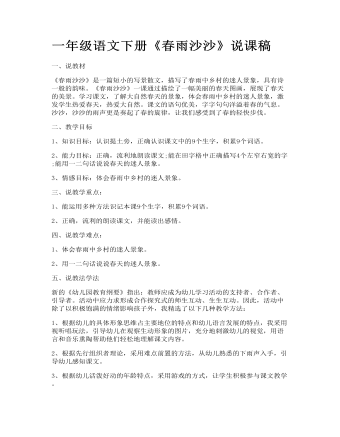
一年级语文下册《春雨沙沙》说课稿
二、教学目标1、知识目标:认识提土旁,正确认识课文中的9个生字,积累9个词语。2、能力目标:正确,流利地朗读课文;能在田字格中正确描写4个左窄右宽的字;能用一二句话说说春天的迷人景象。3、情感目标:体会春雨中乡村的迷人景象。三、说教学重点:1、能运用多种方法识记本课9个生字,积累9个词语。2、正确,流利的朗读课文,并能读出感情。四、说教学难点:1、体会春雨中乡村的迷人景象。2、用一二句话说说春天的迷人景象。五、说教法学法新的《幼儿园教育纲要》指出:教师应成为幼儿学习活动的支持者、合作者、引导者。活动中应力求形成合作探究式的师生互动、生生互动。因此,活动中除了以积极饱满的情绪影响孩子外,我精选了以下几种教学方法:1、根据幼儿的具体形象思维占主要地位的特点和幼儿语言发展的特点,我采用视听唱玩法,引导幼儿在观察生动形象的图片,充分地刺激幼儿的视觉,用语言和音乐熏陶帮助他们轻松地理解课文内容。
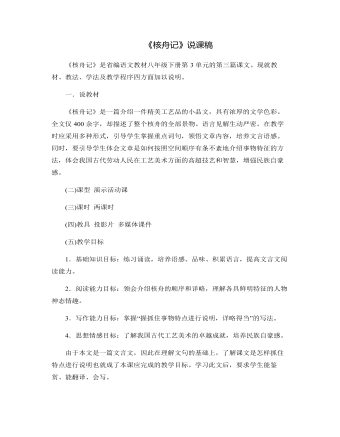
部编版语文八年级下册《核舟记》说课稿
(2)教学内容的设计,一般须遵从学生认知规律,由表及里,由浅入深、完整、生动地呈现事物或事理本身的美学价值。在整体感知课文的艺术美和解决文字障碍之后,通过动手做“核舟”、改写评点“解说词” ,使学生在动手做、动手改、动口说中,理清课文层次和说明顺序。最后,学生们再一次通读全文,使他们的认知经历了从语言文字到形象生动的表象,再到语言文字的完整过程。帮助他们将语言形式和语言内容紧密结合起来。吉尔伯特·海特在其《教学的艺术》一书中曾谈到:“如果我们不能获得一声出自内心的笑,那么这一天的教学就白费了”。通过演课本剧,加深了学生对课文的理解和记忆,有利于培养学生的思考能力,想象能力,逻辑思维能力和语言表达能力。也正是获取一声声出自内心的笑的一种行之有效的方法。
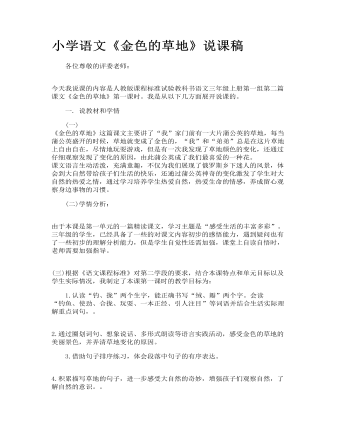
小学语文《金色的草地》说课稿
(二)学情分析: 由于本课是第一单元的一篇精读课文,学习主题是“感受生活的丰富多彩”。三年级的学生,已经具备了一些的对课文内容初步的感悟能力,遇到疑问也有了一些初步的理解分析能力,但是学生自觉性还需加强,课堂上自读自悟时,老师需要加强指导。 (三)根据《语文课程标准》对第二学段的要求,结合本课特点和单元目标以及学生实际情况,我制定了本课第一课时的教学目标为: 1.认读“钓、拢”两个生字,能正确书写“绒、瓣”两个字。会读 “钓鱼、使劲、合拢、玩耍、一本正经、引人注目”等词语并结合生活实际理解重点词句,。 2.通过圈划词句、想象说话、多形式朗读等语言实践活动,感受金色的草地的美丽景色,并弄清草地变化的原因。 3.借助句子排序练习,体会段落中句子的有序表达。 4.积累描写草地的句子,进一步感受大自然的奇妙,增强孩子们观察自然,了解自然的意识。。
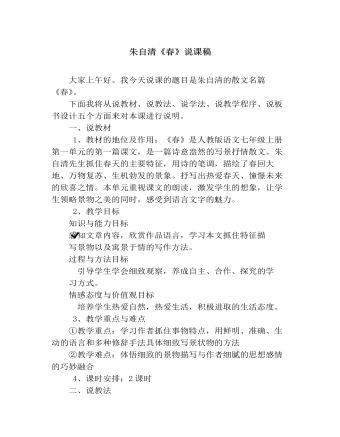
部编版语文七年级上册《春》说课稿
一、说教材1、教材的地位及作用:《春》是人教版语文七年级上册第一单元的第一篇课文,是一篇诗意盎然的写景抒情散文。朱自清先生抓住春天的主要特征,用诗的笔调,描绘了春回大地、万物复苏、生机勃发的景象。抒写出热爱春天、憧憬未来的欣喜之情。本单元重视课文的朗读,激发学生的想象,让学生领略景物之美的同时,感受到语言文字的魅力。2、教学目标知识与能力目标 感知文章内容,欣赏作品语言,学习本文抓住特征描写景物以及寓景于情的写作方法。过程与方法目标引导学生学会细致观察,养成自主、合作、探究的学习方式。情感态度与价值观目标培养学生热爱自然,热爱生活,积极进取的生活态度。3、教学重点与难点 ①教学重点:学习作者抓住事物特点,用鲜明、准确、生动的语言和多种修辞手法具体细致写景状物的方法②教学难点:体悟细致的景物描写与作者细腻的思想感情的巧妙融合
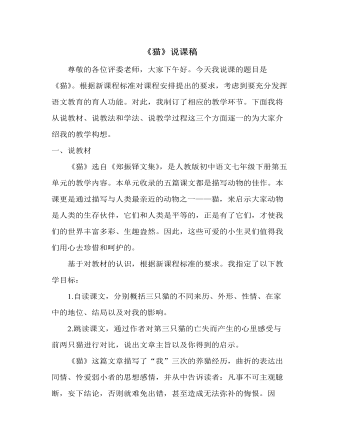
部编版语文七年级上册《猫》说课稿
一、说教材《猫》选自《郑振铎文集》,是人教版初中语文七年级下册第五单元的教学内容。本单元收录的五篇课文都是描写动物的佳作。本课更是通过描写与人类最亲近的动物之一——猫,来启示大家动物是人类的生存伙伴,它们和人类是平等的,正是有了它们,才使我们的世界丰富多彩、生趣盎然。因此,这些可爱的小生灵们值得我们用心去珍惜和呵护的。基于对教材的认识,根据新课程标准的要求。我指定了以下教学目标:1.自读课文,分别概括三只猫的不同来历、外形、性情、在家中的地位、结局以及对我的影响。2.跳读课文,通过作者对第三只猫的亡失而产生的心里感受与前两只猫进行对比,说出文章主旨以及你得到的启示。《猫》这篇文章描写了“我”三次的养猫经历,曲折的表达出同情、怜爱弱小者的思想感情,并从中告诉读者:凡事不可主观臆断,妄下结论,否则就难免出错,甚至造成无法弥补的悔恨。因此,我将教学目标的第一点:概括三只猫的不同来历、外形、性情、在家中的地位、结局以及对我的影响作为本课的教学重点。而说出文章主旨以及得到的启示作为本课教学难点。
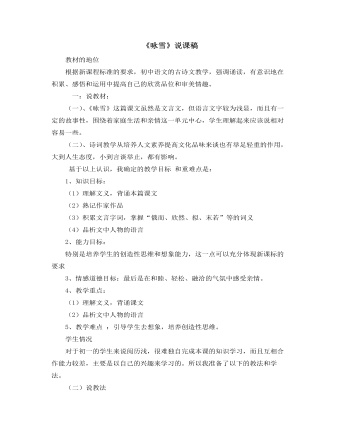
部编版语文七年级上册《咏雪》说课稿
学生情况对于初一的学生来说阅历浅,很难独自完成本课的知识学习,而且互相合作能力较差,主要是以自己的兴趣来学习的。所以我准备了以下的教法和学法。(二)说教法1、情景导入 教学为学生创设了良好的环境,使学生能迅速进入角色。2、朗读教学所谓'读书百遍,其义自见'通过朗读,培养了学生良好的朗读习惯和朗读文言文的语感。3、现场演示法可以更形象的体会优美的句子4、激励创新讲述,发展思维。通过这一环节的迁移训练,不但提高了学生的思维能力,而且拓展了学生的思维空间和想象能力。练习的设计能照顾到全体学生,体现层次性。5、淡化教师角色,体现学生主体地位。这堂课教师是作为一个协作者,对学生进行必要的指导,大部分时间都能体现学生参与学习的过程,学生是课堂的主体。(三) 说学法本人更注重师生之间的互动和学生与学生之间的互动,通过自问自答、自问他答或老师解答等形式,充分调动了学生学习的积极性。
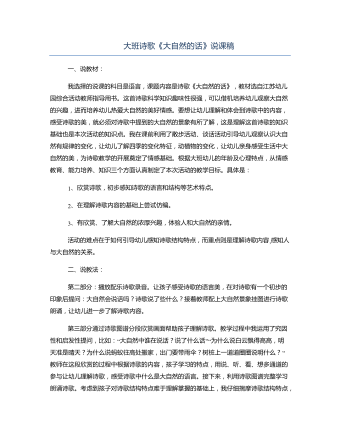
大班诗歌《大自然的话》说课稿
我选择的说课的科目是语言,课题内容是诗歌《大自然的话》,教材选自江苏幼儿园综合活动教师指导用书。这首诗歌科学知识趣味性很强,可以借机培养幼儿观察大自然的兴趣,进而培养幼儿热爱大自然的美好情感。要想让幼儿理解和体会到诗歌中的内容,感受诗歌的美,就必须对诗歌中提到的大自然的景象有所了解,这是理解这首诗歌的知识基础也是本次活动的知识点。我在课前利用了散步活动、谈话活动引导幼儿观察认识大自然有规律的变化,让幼儿了解四季的变化特征,动植物的变化,让幼儿亲身感受生活中大自然的美,为诗歌教学的开展奠定了情感基础。根据大班幼儿的年龄及心理特点,从情感教育、能力培养、知识三个方面认真制定了本次活动的教学目标。具体是:1、欣赏诗歌,初步感知诗歌的语言和结构等艺术特点。2、在理解诗歌内容的基础上尝试仿编。3、有欣赏、了解大自然的浓厚兴趣,体验人和大自然的亲情。
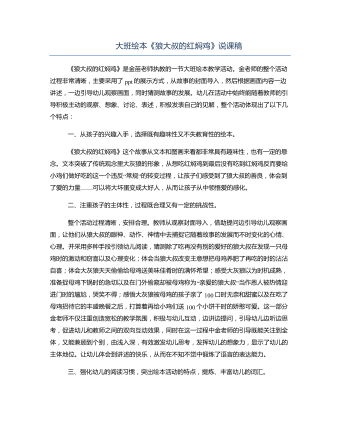
大班绘本《狼大叔的红焖鸡》说课稿
整个活动过程清晰,安排合理。教师从观察封面导入,借助提问边引导幼儿观察画面,让他们从狼大叔的眼神、动作、神情中去捕捉它随着故事的发展而不时变化的心情、心理。并采用多种手段引领幼儿阅读,猜测除了吃再没有别的爱好的狼大叔在发现一只母鸡时的激动和窃喜以及心理变化;体会当狼大叔改变主意想把母鸡养肥了再吃的时的沾沾自喜;体会大灰狼天天偷偷给母鸡送美味佳肴时的满怀希望;感受大灰狼以为时机成熟,准备捉母鸡下锅时的急切以及在门外偷窥却被母鸡称为“亲爱的狼大叔”当作恩人被热情迎进门时的尴尬,哭笑不得;感悟大灰狼被母鸡的孩子亲了100口时无奈和甜蜜以及在吃了母鸡招待它的丰盛晚餐之后,打算着再给小鸡们送100个小饼干时的娇憨可爱。这一部分金老师不仅注重创造宽松的教学氛围,积极与幼儿互动,边讲边提问,引导幼儿边听边思考,促进幼儿和教师之间的双向互动效果,同时在这一过程中金老师的引导既能关注到全体,又能兼顾到个别,由浅入深,有效激发幼儿思考,发挥幼儿的想象力,显示了幼儿的主体地位。让幼儿体会到讲述的快乐,从而在不知不觉中锻炼了语言的表达能力。
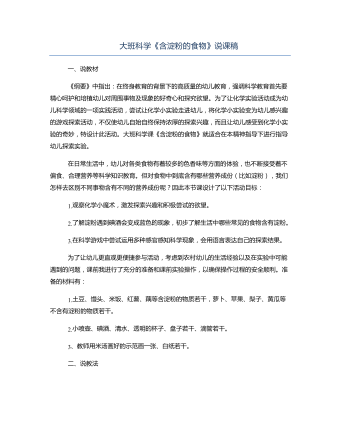
大班科学《含淀粉的食物》说课稿
《纲要》中指出:在终身教育的背景下的高质量的幼儿教育,强调科学教育首先要精心呵护和培植幼儿对周围事物及现象的好奇心和探究欲望。为了让化学实验活动成为幼儿科学领域的一项实践活动,尝试让化学小实验走进幼儿,将化学小实验变为幼儿感兴趣的游戏探索活动,不仅使幼儿自始自终保持浓厚的探索兴趣,而且让幼儿感受到化学小实验的奇妙,特设计此活动。大班科学课《含淀粉的食物》就适合在本精神指导下进行指导幼儿探索实验。在日常生活中,幼儿对各类食物有着较多的色香味等方面的体验,也不断接受着不偏食、合理营养等科学知识教育。但对食物中到底含有哪些营养成份(比如淀粉),我们怎样去区别不同事物含有不同的营养成份呢?因此本节课设计了以下活动目标:1.观察化学小魔术,激发探索兴趣和积极尝试的欲望。2.了解淀粉遇到碘酒会变成蓝色的现象,初步了解生活中哪些常见的食物含有淀粉。3.在科学游戏中尝试运用多种感官感知科学现象,会用语言表达自己的探索结果。
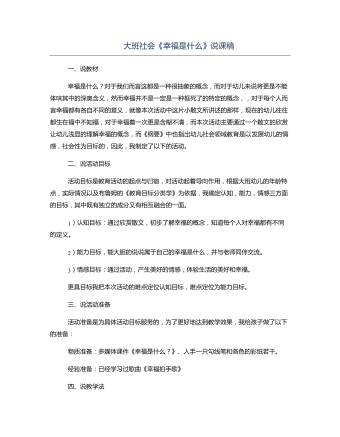
大班社会《幸福是什么》说课稿
幸福是什么?对于我们而言这都是一种很抽象的概念,而对于幼儿来说将更是不能体味其中的深奥含义,然而幸福并不是一定是一种框死了的特定的概念,,对于每个人而言幸福都有各自不同的意义,就像本次活动中这片小散文所讲述的那样,现在的幼儿往往都生在福中不知福,对于幸福着一次更是含糊不清,而本次活动主要通过一个散文的欣赏让幼儿浅显的理解幸福的概念,而《纲要》中也指出幼儿社会领域教育是以发展幼儿的情感,社会性为目标的,因此,我制定了以下的活动。活动目标是教育活动的起点与归宿,对活动起着导向作用,根据大班幼儿的年龄特点,实际情况以及布鲁姆的《教育目标分类学》为依据,我确定认知,能力,情感三方面的目标,其中既有独立的成分又有相互融合的一面。1)认知目标:通过欣赏散文,初步了解幸福的概念,知道每个人对幸福都有不同的定义。2)能力目标,能大胆的说说属于自己的幸福是什么,并与老师同伴交流。3)情感目标:通过活动,产生美好的情感,体验生活的美好和幸福。
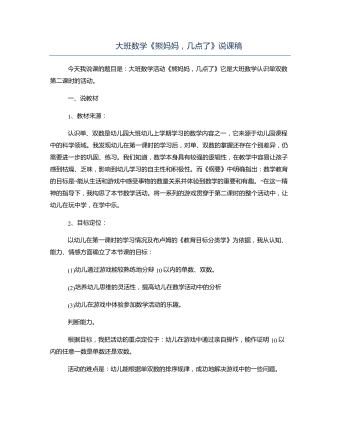
大班数学《熊妈妈,几点了》说课稿
认识单、双数是幼儿园大班幼儿上学期学习的数学内容之一,它来源于幼儿园课程中的科学领域。我发现幼儿在第一课时的学习后,对单、双数的掌握还存在个别差异,仍需要进一步的巩固、练习。我们知道,数学本身具有较强的逻辑性,在教学中容易让孩子感到枯燥、乏味,影响到幼儿学习的自主性和积极性。而《纲要》中明确指出:数学教育的目标是“能从生活和游戏中感受事物的数量关系并体验到数学的重要和有趣。”在这一精神的指导下,我构思了本节数学活动。将一系列的游戏贯穿于第二课时的整个活动中,让幼儿在玩中学,在学中乐。以幼儿在第一课时的学习情况及布卢姆的《教育目标分类学》为依据,我从认知、能力、情感方面确立了本节课的目标:(1)幼儿通过游戏能较熟练地分辩10以内的单数、双数。(2)培养幼儿思维的灵活性,提高幼儿在数学活动中的分析(3)幼儿在游戏中体验参加数学活动的乐趣。
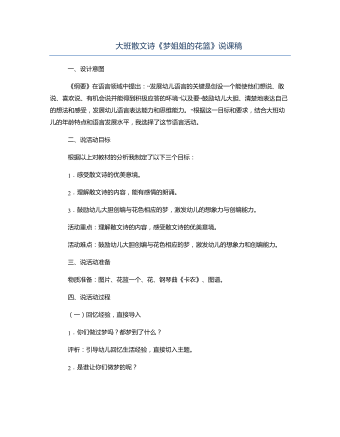
大班散文诗《梦姐姐的花篮》说课稿
《纲要》在语言领域中提出:“发展幼儿语言的关键是创设一个能使他们想说、敢说、喜欢说、有机会说并能得到积极应答的环境”以及要“鼓励幼儿大胆、清楚地表达自己的想法和感受,发展幼儿语言表达能力和思维能力。”根据这一目标和要求,结合大班幼儿的年龄特点和语言发展水平,我选择了这节语言活动。根据以上对教材的分析我制定了以下三个目标:1.感受散文诗的优美意境。2.理解散文诗的内容,能有感情的朗诵。3.鼓励幼儿大胆创编与花色相应的梦,激发幼儿的想象力与创编能力。活动重点:理解散文诗的内容,感受散文诗的优美意境。活动难点:鼓励幼儿大胆创编与花色相应的梦,激发幼儿的想象力和创编能力。